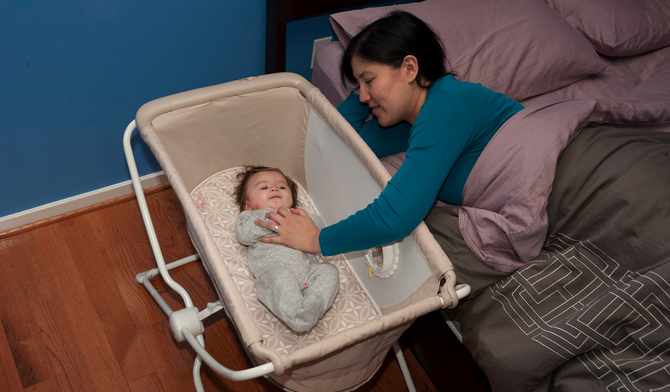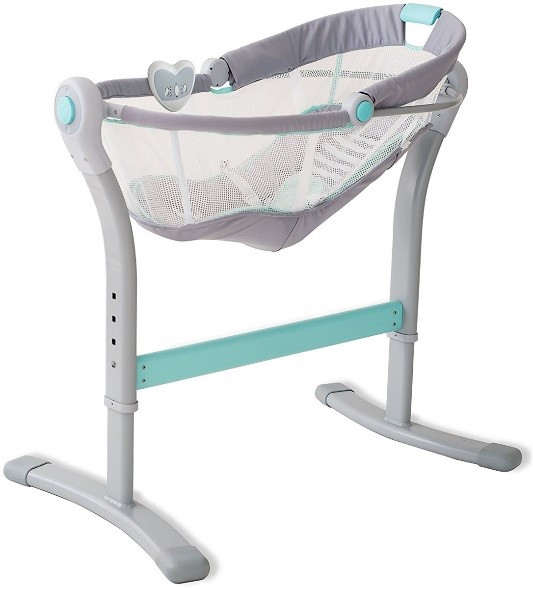When Does SIDS Risk End?
Sudden Infant Death Syndrome (SIDS) is the sudden and unexplained death of an infant under one year of age. The risk for SIDS peaks between ages 2 and 4 months, with the majority of deaths occurring before six months. After this peak, the risk gradually decreases until it plateaus at around 12 months of age.
It is important to remember that although the risk for SIDS declines after 6-12 months, there can still be cases reported in infants up to one year old. Therefore, parents should continue to practice safe sleep habits throughout their child’s first year even if they are past the peak period for SIDS risks.
SIDS is a rare and unpredictable event, but the risk of Sudden Infant Death Syndrome (SIDS) does end. The American Academy of Pediatrics recommends that infants be placed to sleep on their backs until they reach 12 months old as this has been found to reduce the risk of SIDS. After the age of 1 year, your infant will no longer be at an increased risk for SIDS.
However, it’s important to continue practicing safe sleeping habits like placing your baby on their back and having them sleep in a crib or bassinet throughout infancy and toddlerhood.

Credit: www.heraldnet.com
When Can You Stop Worrying About Sids?
When it comes to Sudden Infant Death Syndrome (SIDS), it can be hard for parents not to worry about the safety of their babies. While there is no guaranteed way to prevent SIDS, there are some steps that can help reduce the risk. Once your baby turns one year old, they will have reached a major milestone in terms of development and survival.
This is when many experts suggest you can stop worrying about SIDS. After this age, the incidence rate drops dramatically and your child is less likely to be affected by this tragic syndrome. It’s important however, that even after your baby has turned one year old, you continue to practice safe sleep habits such as placing them on their back while sleeping; keeping loose blankets and toys out of the crib; using a firm mattress with a tight-fitting sheet and avoiding overheating them during sleep time.
Following these guidelines may help ensure your child has a safe sleep environment which could potentially lower their risk of developing any kind of health issue including SIDS.
What is the Number 1 Cause of Sids?
Sudden Infant Death Syndrome (SIDS) is a frightening and devastating phenomenon for parents. It is defined as the sudden, unexplained death of an infant under one year of age. The exact cause of SIDS remains unknown; however, researchers have identified some potential risk factors associated with it.
The number one cause of SIDS appears to be tummy sleeping. When an infant sleeps on their stomach or side without proper support and monitoring, they are at greater risk for SIDS due to the fact that they may experience difficulty breathing in this position. Research has shown that when infants sleep on their backs, there is a decreased risk for SIDS compared to other positions such as tummy or side-sleeping.
Additionally, soft bedding materials like blankets and pillows can increase the likelihood of fatalities from suffocation if used during sleep time so these should always be avoided in baby’s cribs or bassinets when possible.
What is the Highest Month for Sids?
Sudden Infant Death Syndrome (SIDS) is a devastating and mysterious phenomenon that can occur during any month of the year. While it’s impossible to predict or prevent, there is some evidence to suggest that SIDS cases peak in certain months. In fact, studies have found that the highest rate of SIDS deaths occur in October and November, with a slight dip in December before peaking again in January.
This suggests an environmental factor like colder temperatures may be at play as these are typically the colder months of the year; however, other factors such as increased exposure to respiratory illnesses during this time could also contribute. Additionally, parents should be aware that African American infants have higher rates of SIDS than Caucasian infants throughout every month of the year – so regardless of season or time frame, it’s important for all caregivers to remain mindful and vigilant when caring for their babies.
Can You Stop Sids While It’S Happening?
Unfortunately, there is currently no way to stop Sudden Infant Death Syndrome (SIDS) while it is happening. SIDS is the sudden and unexpected death of an infant aged less than one year old and remains one of the leading causes of infant mortality in many countries. While research has yet to identify a single cause for SIDS, experts believe that it occurs when a combination of factors place an infant at risk for sleep-related death.
These may include things such as sleeping on their stomachs, getting overheated from too much bedding or clothing during sleep, exposure to tobacco smoke before or after birth, sleeping with parents in the same bed, or having a low birth weight. Parents can reduce their baby’s risk by taking simple steps like always placing your baby on his/her back to sleep; making sure your baby sleeps alone in his/her own crib; avoiding smoking around your child; using tight fitting sheets and blankets; dressing them lightly for sleep; using pacifiers during naps and nighttime sleepings if desired; breastfeeding if possible; and ensuring regular well-baby checkups are scheduled with their pediatrician.
SIDS Sudden Infant Death Syndrome Risks | Nursing Educate Parents NCLEX Tips
Why Does Sids Peak at 2-4 Months
Sudden Infant Death Syndrome (SIDS) is the sudden and unexplained death of an infant under one year of age. While SIDS can occur at any time during a baby’s first year, it typically peaks between 2-4 months. Although researchers are still trying to determine why this age group may be more vulnerable, possible factors include immature cardiorespiratory control centers in the brain which could make them unable to respond effectively to a dangerous situation such as suffocation or overheating.
My Baby Died of Sids in My Arms
Losing a child is every parent’s worst nightmare. Unfortunately, for many parents this reality becomes a harsh truth when their child dies of SIDS (Sudden Infant Death Syndrome). This heartbreaking experience can leave parents feeling helpless and confused as to why it happened.
For many, there is no explanation or understanding of why it occurred. The pain from losing a baby in such an unexpected way will remain with the family forever and often causes immense grief that may be difficult to cope with for years afterwards.
Oldest Baby to Die from Sids
In 1995, a baby girl born in India was reported as the oldest infant to have died from SIDS (Sudden Infant Death Syndrome). She was 11 months old at the time of death, making her one of the oldest babies on record to die from this condition. The cause of death was ruled as “undetermined” by medical experts due to an incomplete autopsy and limited family information about her health history.
Although rare, SIDS can affect infants up to one year old or older in some cases.
Signs of Sids before It Happens
SIDS is an unexpected death of an infant that can be difficult to detect beforehand. While there are no definite signs or warning signals of SIDS, some studies have identified certain behaviors that may increase the risk, such as babies sleeping on their stomachs and being exposed to cigarette smoke in the home. Additionally, research has found a link between SIDS and infants under 4 months old who do not move around much during sleep or experience changes in breathing patterns like long pauses between breaths.
It’s important for parents to monitor their child’s behavior and learn about ways to reduce the risk factors of SIDS.
How Common is Sids
Sudden Infant Death Syndrome (SIDS) is the leading cause of death for infants between one month and one year old, accounting for about 22% of all infant deaths in the United States. While this may seem like a large number, SIDS remains relatively rare with an estimated 4,500 babies dying from it annually. However, due to its unknown cause and lack of warning signs or symptoms, parents should remain vigilant in their efforts to reduce the risk of SIDS.
Sids Risk by Weight
According to the American Academy of Pediatrics, research has found that babies born at a low birth weight are at an increased risk for SIDS. Low birth weight is defined as less than 2,500 grams (5 pounds 8 ounces), and this category includes premature infants. Additionally, it has been found that larger babies may also be more likely to develop SIDS due to their underdeveloped respiratory systems which makes them more vulnerable during periods of sleep apnea.
Sids Age 2 Years
Sudden infant death syndrome (SIDS) is a tragedy that can strike any family regardless of age, race or gender. Although it is most common in babies under 1 year old, SIDS still occurs in children up to 2 years of age. According to the American Academy of Pediatrics, about one-third of all SIDS deaths occur at between 1 month and 1 year old, while another one-third occur between ages 1 and 2 years.
Therefore, parents should remain vigilant in their efforts to reduce the risk for SIDS even after their child has passed the first year mark.
Sids Risk by Age
SIDS risk is highest during the first 6 months of life, with nearly 90% of SIDS deaths occurring before a baby’s first birthday. Although SIDS can occur any time during infancy and early childhood, the risk dramatically decreases after one year of age. By two years old, the risk for SIDS is much lower than it was in the earlier months.
It’s important to note that even though babies are at their highest risk in those very early days and weeks, safe sleep practices should be continued throughout infancy and toddlerhood.
Conclusion
Overall, it is clear that SIDS risk does not end when a baby reaches their first birthday. Although the rate of SIDS decreases significantly after this age, parents should still be aware of potential risks and take the necessary precautions to reduce them. Other important measures include creating a safe sleep environment for infants, avoiding smoking during pregnancy and using approved infant car seats.
While there is no guaranteed way to prevent SIDS entirely, these steps can help reduce its occurrence.







